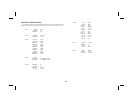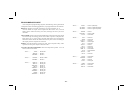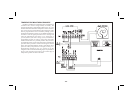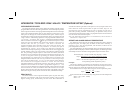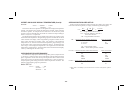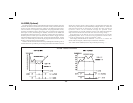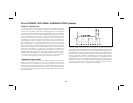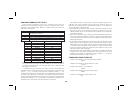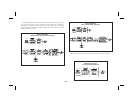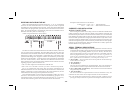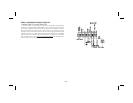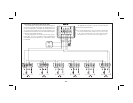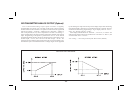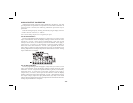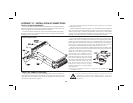
SENDING COMMANDS TO THE IMY
When sending commands to the unit a command string must be
constructed. The command string may consist of command codes, value
identifiers, and numerical data. Below is a table outlining the codes the
indicator will recognize.
COMMAND FUNCTIONS
T transmits the requested information specified by the
identifier (A-I, K, and L)
V change a value specified by the identifier (C-F, K, and L)
N address a particular indicator in a multiple unit loop (0-99)
R reset a value specified by the identifier (B-D, G, H, I, and J)
P print per programmable print options (A-I)
VALUE IDENTIFIERS SERIAL MNEMONICS
A temperature INP
B integrator/totalizer TOT
C alarm #1 AL1
D alarm #2 AL2
E hysteresis #1 HS1
F hysteresis #2 HS2
G peak reading PEK
H valley reading VAL
I zero offset OFS
J offset input
K analog low ANL
L analog high ANH
Note: RJ - offsetthe input(re-zeros). When theinput isoffset (via frontpanel or
“RJ”) the amount is stored in the offset reading (I). Ex. When an offset is
performed, the display reads“5.0”, the offset value will be “-00005.0”(and
the display will show 0.0).
A command string is constructed by using the above commands and
identifiers along with any data values that are required. The indicator will
accept “+” or “-” in front of the data value. Numbers without “+” are
understood to be positive. Leading zeros can be eliminated and both lower
and upper case characters are accepted. The address command is used to
allowa command tobe directedto a specificunit onthe loop. Ifthe indicator
is assigned an address of “0”, transmission of the address command is not
required. This is done where only one indicator is in the loop.
The command string is constructed in a specific logical sequence. The
indicator will reject command strings that do not conform. Only one
operation can be performed per command string. Below is a description of
how to construct a command string.
1.Iftheindicatorhasanaddressotherthanzero,thefirsttwocharactersofthe
string must consist of the address command (N) followed by the unit
address number (0-99). If the indicator has an address of 0, the address
command is optional.
2. Thenext twocharacters in thestring are the actual command the indicator
must perform and the identifier on which it operates. Command P-print,
Value I-zerooffset and J-offset input, have impliedoperators and need no
additional characters.
3. If the change value command is being used (V), the next characters in the
string after the value identifier, are the numerical data. When sending
numericaldata,suchaschangeanalarmvalue,thecorrectnumberofdigits
to the right, must be included. As an example, to change an alarm value
from 150.2 to 50.0. Sending 50 would cause the indicator to see 5.0 and
change the alarm value accordingly.
4.Allcommands mustbeterminated byan asterisk(*).Theindicator willnot
respond to any other code. Carriage return and line feed are not valid
terminators and should be suppressed with the character “;”, if using a
BASIC print statement (ex. Print “N9TA*”;).
COMMAND STRING EXAMPLES
Indicator with address 3, transmit temperature reading.
N3TA*
Indicator with address 0, change alarm #1 to 150.
VC150*
Indicator with address 1, reset totalizer.
N1RB*
Indicator with address 99, print the print options.
N99P*
Indicator with address 0, zero the offset value.
RI*
-28-



